In 2020 I was selected as a National Oceanic and Atmospheric Administration (NOAA) Educational Partnership Program with Minority Serving Institutions (EPP/MSI) undergraduate scholar.
While the pandemic has impacted the work of many scientists, this summer, the life of researchers and biologists has been restored. I was able to intern with NOAA at the Marine Mammal and Turtle Division Southeast Fisheries Science Center, National Marine Fisheries Service performing lab work and undertaking fieldwork with the National Marine Mammal Foundation. My focal area of research is healthy oceans; for this project we sought to understand how to most effectively preserve cetacean skin samples for future genetic analysis.
Epigenetics is a novel technology in the field of marine mammalogy and can be used as a novel tool to estimate age in common bottlenose dolphins (Tursiops truncatus). Cetacean skin samples have been archived for decades using a variety of different storage media and there is interest in aging these historic samples. Given this interest, it has been beneficial to evaluate the various storage options and identify which method(s) sufficiently preserve the DNA in the archived skin for epigenetic aging. One commonly used storage medium is 20% dimethyl sulfoxide (DMSO) saturated with sodium chloride. This preservative has proven effective at preserving DNA for other types of analyses and is extremely useful because it does not require use of hazardous solvent or cold storage. The primary objective of this study was to identify whether 20% salt- saturated DMSO is an effective long-term storage medium for preserving cetacean DNA quality over time for epigenetic studies, by examining the quality of DNA extracted from tissues stored for varying amounts of time.
DNA extractions were performed in the lab under the supervision of my mentor, Dr. Patricia Rosel, on 55 skin samples. The samples were categorized based on their initial collection date, initial extraction date and their second extraction date which I performed. I wanted to find out how much the DNA quality degraded over time so we compared the quality of DNA at the first extraction to the second extraction. The DNA quality and quantity were assessed from the DNA obtained from a standardized amount of skin (10-25mg). After each DNA extraction, the DNA quality was visualized using gel electrophoresis and GelDoc Go Imaging System and assessed with the laboratory’s DNA quality scoring protocol.
My results are encouraging for the use of the archived tissues for DNA methylation studies for epigenetic aging as 41 of the 55 preserved tissue samples from extraction #2 were classified as excellent or good quality DNA, even samples preserved as long as 20 years ago. Due to the lack of a consistent correlation between DNA quality and preservation time, next steps for this work will be to consider other variables such as whether the sample was collected from a live animal or a carcass. An additional next step will be to examine whether there is any correlation between epigenetic age estimation error and the DNA quality and tissue storage times.

In the field, I worked alongside my co-mentor, Dr. Ashley Barratclough with the National Marine Mammal Foundation. This experience allowed me to further understand the full scope of procedures for assessing the health of wild dolphins. The health of the animal and its stressors, along with the safety of the crew, was of most concern. Assessments include blood sampling, physical examination and release of the dolphin. Every person on the crew had a job, I was around many scientists, biologists and veterinarians, each of which allowed me to assist them in their duties. The fast-paced environment of being in the field was, for me, both invigorating and tense, yet the relationships that were fostered aimed to ensure we got the job done.
During the final week of my internship, I presented my findings. Every individual funded by the NOAA EPP/MSI Undergraduate Scholarship Program was scored based on their focal area of research; for healthy oceans, I was awarded first place in recognition of my presentation at the 2022 summer symposium. I am currently in my senior year of college and in Spring 2023 I will be graduating with my bachelors degree in Environmental Science.





